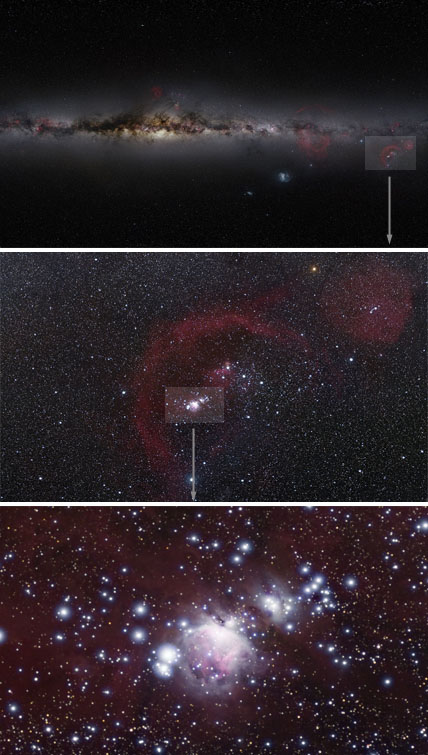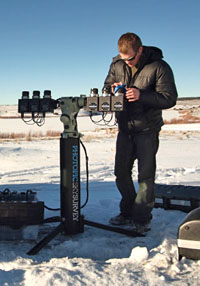For the record, I am a lousy astrophotographer. I'm sure I'd get better with practice, but frankly I'm happy just eyeballing the universe instead of trying to focus ancient photons onto a light-sensitive chip. Besides, the world is full of great astro-imagers.
My first encounter with a world-class astrophotographer was Hans Vehrenberg, who by the 1970s had become renowned for his exquisite black-and-white portraits of celestial objects in the northern and southern sky. His Atlas of Deep-Sky Splendors still has a favored location on my bookshelf. Later came David Malin, who dazzled us with incredible color views of the southern-sky showpieces. (No wonder: his "camera" was the 3.9-m Anglo-Australian Telescope.)

By recording 624 individual sky fields, each 12° across, Nick Risinger could produce an all-sky composite that looks spectacular whether viewed as a wide-field panorama or when zoomed in close.
Nick Risinger
This week I was blown away again, by a little-known astrophotographer named Nick Risinger. A Seattle-based marketing director by day, Risinger began his photon-driven quest by asking the simple question, "What do you see at night?"
Now he knows, having captured the entire celestial sphere in a way that attempts to convey the night sky's grandeur at scales big and small. His Photopic Sky Survey was a mind-boggling undertaking: 37,440 digital exposures, taken over the course of a year from sites in North America and South Africa, that he painstakingly stitched together to create a single, 5-gigapixel image.
It wasn't easy. Risinger ended up quitting his job and, with the aid of his father and brother, traveled 60,000 miles with his unique photography setup. It consisted of six Finger Lakes ML-8300 monochrome cameras with 85-mm f/2.8 lenses bolted onto a Takahashi EM-11 Temma 2 mount. To ensure complete coverage, Risinger subdivided the sky into 624 fields, each just 12° across. He estimates that he's captured some 20 million stars in all.

Nick Risinger prepares to photograph the night sky from a site in Colorado. On this particular night, the temperature dropped to -6°F (-21°C).
Nick Risinger
This isn't the most comprehensive all-sky photography undertaken (the Digitized Sky Survey, released in 1994, wins that prize). So don't expect any scientific breakthroughs from it.
Nor is this the first all-sky effort by an amateur: among others, there's Desktop Universe, completed in 2002 and later incorporated into the popular Starry Night software, and Axel Mellinger's two efforts (one accomplished on film, another wholly digital).
But what sets Risinger's work apart is its depth — revealing, he explains, "glowing factories of newborn [stars] and a rich tapestry of dust all floating on a stage of unimaginable proportions." It affords you the chance to float leisurely across the sky at your leisure and then stop and zoom in for some in-depth sightseeing.°
Try out both of his tour methods: a scrollable, zoomable all-sky panorama, or an interactive version with constellation stick figures, star names, and more.
 11
11









Comments
Anthony Barreiro
May 13, 2011 at 1:15 pm
This is truly an awesome accomplishment, and a great gift to the world. Even if this project doesn't lead to any new scientific discoveries, it will still help people to see and know the sky in both greater breadth and greater depth.
You must be logged in to post a comment.
Jack Flickinger
May 13, 2011 at 5:36 pm
Simply amazing! I commend Mr. Risinger for his dedication to this huge undertaking, as well as his father and brother for their help and support. Will there be a downloadable version of this?
You must be logged in to post a comment.
Alison
May 13, 2011 at 6:09 pm
This is very cool -- like a Gigapan zoomable photo. Thanks to S&T for finding these cool things to tell us about.
He does have prints & downloadable versions on his website, skysurvey.org.
You must be logged in to post a comment.
Chuck Spann
May 13, 2011 at 9:26 pm
WOW! This is something I wish I had when I was a teenager hobbyist back in the 70s. This gives you a truer perspective on where things are and how big that you don't get from most star charts. Thank you Nick Risinger!
You must be logged in to post a comment.
rdc
May 14, 2011 at 3:54 pm
When reading the article, i thought, 'that's nice'. But the interactive website is truly mind blowing. And i dont say that very often.
You must be logged in to post a comment.
ceegeeSeattle
May 14, 2011 at 6:49 pm
Not only is this exquisitely amazing, it's an inspiration to all the young folks out there who might now have encouragement to be more curious about their universe. This is tremendous. After writing to Nick, I found out that he will be working toward less expensive posters that would be a wonderful gift to your children's schools...or just hang it in your fav spot. Great stuff Nick & thanks for doing this article, Kelly. AFter reading it in our local paper, I was wondering if you would.
You must be logged in to post a comment.
Alain Maury
May 15, 2011 at 5:33 pm
Hello Kelly,
There was also the whole sky image produced by Serge Brunier in cooperation with ESO during AMA2009
http://sergebrunier.com/gallerie/pleinciel/ (this is a zoomify image too).
Alain
You must be logged in to post a comment.
Corbett
May 17, 2011 at 7:10 pm
Guys this is truly remarkable and I think it should stay as a permanent part of your web site.
You must be logged in to post a comment.
Jack Flickinger
May 18, 2011 at 6:49 pm
@ Corbett: I agree with you 100 %. This is a timeless work of art and should become a regular fixture here at S&T.
@ Allison: Thanks for the info,I'm downloading now! 🙂
You must be logged in to post a comment.
Lawrence
June 5, 2011 at 4:27 am
Awaesome and amazing astrophotos...
Need more research on new discovery of astronomy objects in the universe. There is more to discover each day as some of the stars light yet to reach Earth..14.6 billion light years.
Kudos to You, Nick Risinger for your excellent efforts and passion in astrophotography.
Keep your work up and continuously seek for refinement of works. Good Luck in your search.
You must be logged in to post a comment.
Charles Martin
January 24, 2012 at 10:27 pm
How come I didn't see any jet plane or satellite or meteor light trails? Just kidding. This is my kind of project if I were 40 years younger and a little richer.
We need more armature astrometry mosaic photographs.
I like the big picture.
You must be logged in to post a comment.
You must be logged in to post a comment.